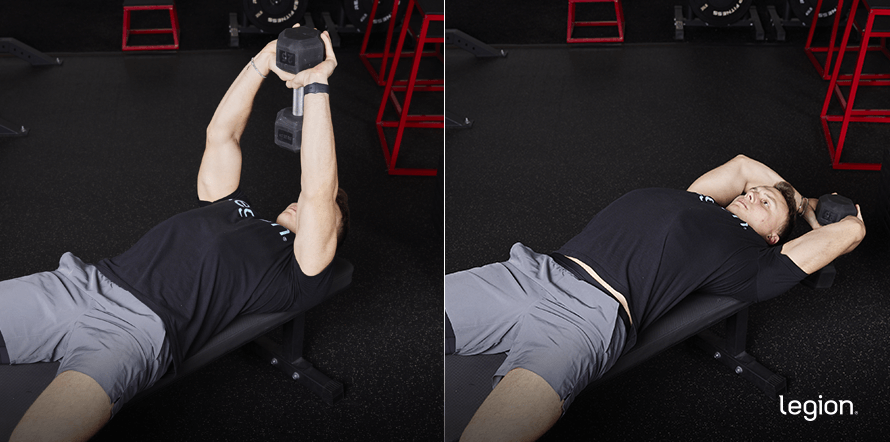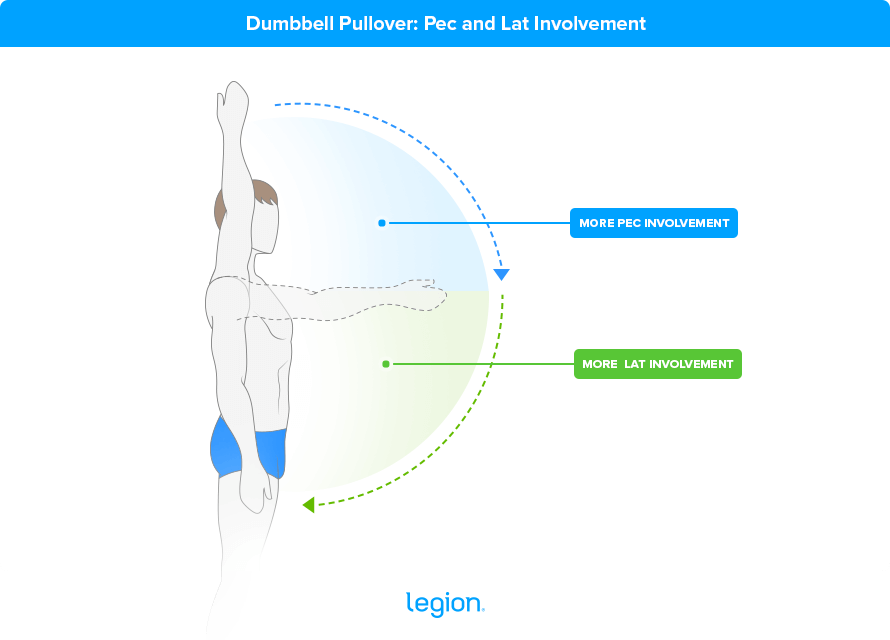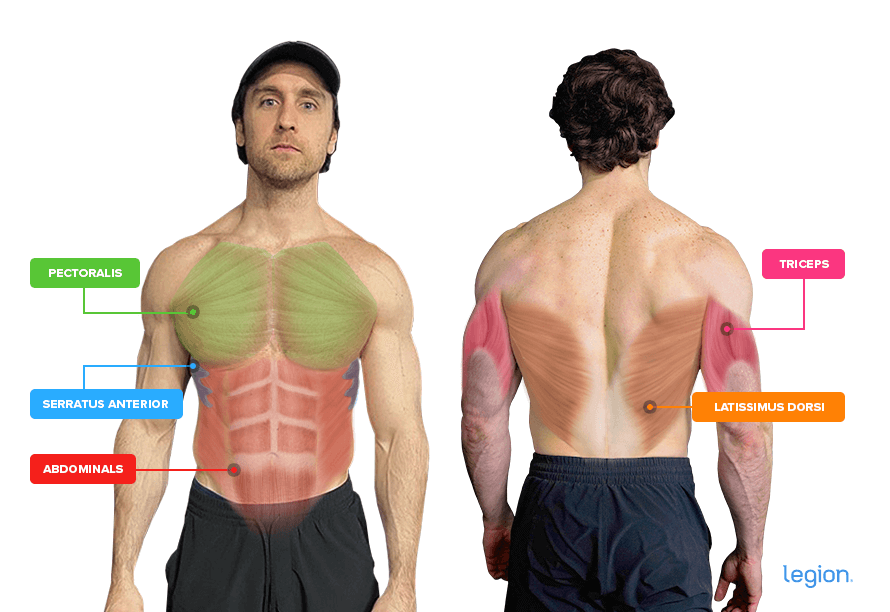The dumbbell pullover is an “old-school” bodybuilding exercise that primarily trains your chest and lats.
It’s recently regained favor because it trains several major upper body muscle groups in a stretched position—a factor new research highlights as crucial for muscle growth.
It also enhances shoulder flexibility and requires minimal equipment, making it both functional and accessible.
In this article, you’ll learn what the dumbbell pullover is, how to perform it with proper form, which muscles it works (especially whether it targets the chest or lats more), its benefits, common mistakes, the best dumbbell pullover alternatives and variations, and more.
What Is the Dumbbell Pullover Exercise?
The dumbbell pullover is a compound exercise that primarily trains the pecs and lats.
To perform the dumbbell pullover, lie on your back on a bench and hold a dumbbell by one end directly over your chest using both hands. While keeping your arms mostly straight, lower the dumbbell in an arc toward the floor until your upper arms are next to your ears, before returning the dumbbell back to the starting position.
How to Do the Dumbbell Pullover Exercise

1. Set up
Lie supine on a flat bench with your feet on the floor and your head as close to the end of the bench as possible. Using both hands, hold a dumbbell by one end over your chest with your palms facing the ceiling and your arms almost straight.
Tuck your shoulder blades down and squeeze them together.
2. Descend
While maintaining a slight bend in your elbows, lower the dumbbell in an arc over your head until your biceps are next to your ears.
3. Pullover
Reverse the movement and return to the starting position.
Are Dumbbell Pullovers a Chest or Lat Exercise?
The pecs and lats work together to extend the shoulder joint (bring your arms from overhead to your sides by moving in an arc in front of you).
As shoulder extension is the main movement involved in the pullover, it trains both the pecs and lats to a high degree.
That said, most research shows the pullover exercise is more effective at training the pecs than the lats, a fact that makes sense given what we know about how these muscles contribute to shoulder extension.
The pecs contribute most to shoulder extension as you move your arm from overhead to out in front of you, whereas the lats do the majority of the work moving your arms from out in front of you to your sides and beyond.
Here’s a diagram to illustrate this:

This is why research shows that exercises like the cable pullover, which focus on the final part of shoulder extension, are better for training the lats. In contrast, exercises like the dumbbell pullover, which emphasize the start of this movement, are more effective for the pecs.
Many weightlifters wonder whether they can alter dumbbell pullover form to maximize pec or lat involvement.
Although there’s no specific research on this, people typically report feeling their pecs more when they tuck their upper arms so that their elbows point to the ceiling when you extend your arms overhead. Likewise, people generally say they feel their lats working more when they allow their elbows to flare so that they point out to sides when the dumbbell is overhead.
The extent to which these “feelings” translate into long-term muscle gain is unclear. However, many experts believe a strong “mind-muscle connection” is beneficial for growth. Therefore, if it helps you “connect” with the muscles you’d prefer to develop, it’s a low-risk, potentially high-reward strategy worth trying.
Dumbbell Pullover: Benefits
1. It develops all-around upper-body strength and muscle.
The pullover trains several major muscle groups in your upper body, including your chest, lats, triceps, and abs, making it ideal for gaining upper-body strength and muscle mass.
What’s more, it trains these muscles through a full range of motion and in a stretched position, which several studies show are vital for maximizing muscle growth.
2. It improves shoulder mobility.
The pullover enhances shoulder mobility by stretching and strengthening the muscles around the shoulder joint, enhancing their range of motion and potentially helping to prevent injuries.
3. It‘s highly adaptable.
The dumbbell pullover doesn’t require specialized equipment like a rack or machine—all you need is a sturdy surface to lie on.
You can also perform the pullover with almost any equipment you have available, including a dumbbell, barbell, or kettlebell.
In other words, the pullover is an adaptable exercise for training your upper body, wherever and however you choose to exercise.
Dumbbell Pullover: Muscles Worked
The dumbbell pullover works the . . .
- Pecs
- Lats
- Triceps (specifically the triceps long head)
- Serratus anterior
- Abs
Here’s how the primary muscle groups worked by the dumbbell pullover look on your body:

Common Dumbbell Pullover Mistakes
1. Bending and straightening your elbows.
Excessively bending your elbows as you lower the weight and straightening them as you lift it shifts the emphasis from your pecs and lats to your triceps. To counteract this, fix your elbow angle at the beginning of your set and maintain it consistently throughout.
2. Using too much weight.
Using too much weight can lead to poor form, reduce range of motion, and increase risk of injury. To maximize the pullover’s benefits, it’s essential to choose a weight that allows you to perform the exercise with control and through the full range of motion.
3. Lifting your butt off the bench.
Lifting your butt off the bench while performing the pullover is a sign of overcompensation, often because you’re using too much weight or lack the required flexibility or core stability.
This reduces the effectiveness of the exercise and may increase your risk of injury. To prevent it, engage your core throughout the movement and use a weight that allows you to maintain proper form with your back flat against the bench.
The Best Dumbbell Pullover Alternatives and Variations
1. Cross-Bench Dumbbell Pullover
You perform the cross-bench dumbbell pullover with your body perpendicular to the bench and your upper back resting on the bench. For some, this variation allows for a deeper stretch in the chest and lats, which may aid muscle growth. However, it’s also significantly more unstable than the regular version and requires more lower back mobility, making it less suitable for beginners and those with back issues.
2. Barbell Pullover
The barbell pullover is almost identical to the dumbbell version. The only difference is you use a barbell instead of a dumbbell. As such, you can think of the barbell and dumbbell pullover as interchangeable—do whichever you have equipment for.
3. Single-Arm Dumbbell Pullover
The single-arm dumbbell pullover allows you to train each side of your body independently, which is useful for finding and fixing muscle imbalances.
4. Stability-Ball Dumbbell Pullover
Doing the pullover while lying on a stability ball instead of a bench adds an element of instability, forcing your core to work harder to maintain balance. The drawback is you can use significantly less weight, which negates some of the muscle- and strength-building benefits.
5. Machine Pullover
Using a pullover machine provides consistent resistance throughout each rep, which trains your muscles slightly differently from the free-weight version.
Scientific References +
- Marchetti, Paulo H., and Marco C. Uchida. “Effects of the Pullover Exercise on the Pectoralis Major and Latissimus Dorsi Muscles as Evaluated by EMG.” Journal of Applied Biomechanics, vol. 27, no. 4, 1 Nov. 2011, pp. 380–384, journals.humankinetics.com/view/journals/jab/27/4/article-p380.xml, https://doi.org/10.1123/jab.27.4.380. Accessed 27 Sept. 2021.
- Borges, Eduardo, et al. “Original Article Resistance Training Acute Session: Pectoralis Major, Latissimus Dorsi and Triceps Brachii Electromyographic Activity College of Physical Education YCMA of Sorocaba.” Journal of Physical Education and Sport ® (JPES), vol. 18, no. 2, 2018, pp. 648–653, efsupit.ro/images/stories/iunie2018/Art%2095.pdf, https://doi.org/10.7752/jpes.2018.02095. Accessed 14 Dec. 2023.
- Muyor, José M., et al. “Comparison of Electromyographic Activity during Barbell Pullover and Straight Arm Pulldown Exercises.” Applied Sciences, vol. 12, no. 21, 3 Nov. 2022, p. 11138, https://doi.org/10.3390/app122111138. Accessed 6 Feb. 2023.
- De Almeida Costa Campos, Yuri, et al. “The Use of Barbell or Dumbbell Does Not Affect Muscle Activation during Pullover Exercise.” Scholarworks.calstate.edu, scholarworks.calstate.edu/concern/publications/cr56n386q?locale=en. Accessed 14 Dec. 2023.
- Maeo, Sumiaki, et al. “Triceps Brachii Hypertrophy Is Substantially Greater after Elbow Extension Training Performed in the Overhead versus Neutral Arm Position.” European Journal of Sport Science, 12 July 2022, pp. 1–26, https://doi.org/10.1080/17461391.2022.2100279.
- Sato, Shigeru, et al. “Elbow Joint Angles in Elbow Flexor Unilateral Resistance Exercise Training Determine Its Effects on Muscle Strength and Thickness of Trained and Non-Trained Arms.” Frontiers in Physiology, vol. 12, 16 Sept. 2021, https://doi.org/10.3389/fphys.2021.734509.
- Pedrosa, Gustavo F., et al. “Partial Range of Motion Training Elicits Favorable Improvements in Muscular Adaptations When Carried out at Long Muscle Lengths.” European Journal of Sport Science, 23 May 2021, pp. 1–11, pubmed.ncbi.nlm.nih.gov/33977835/, https://doi.org/10.1080/17461391.2021.1927199.










